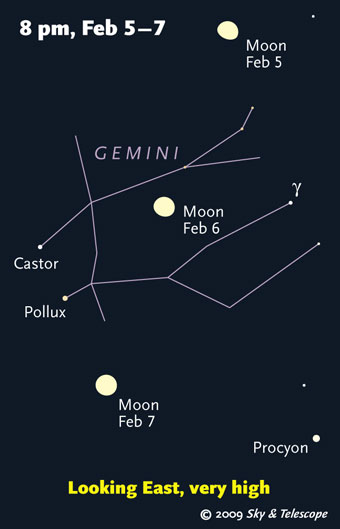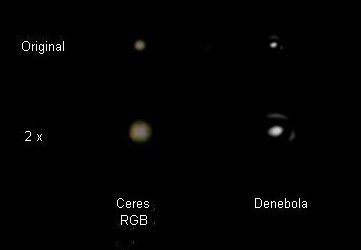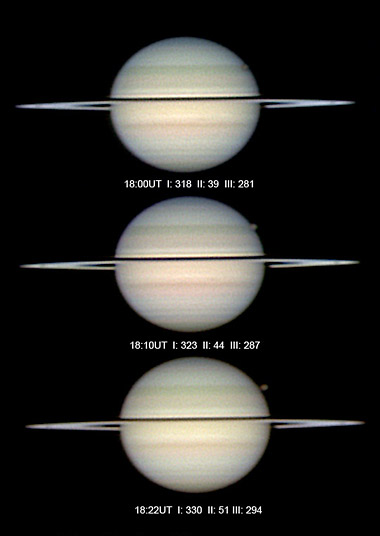Some daily events in the changing sky for February 6 – 14.

As the Moon waxes toward full, watch it cross Gemini in the evening sky. (These scenes are drawn for the middle of North America. European observers: move each Moon symbol a quarter of the way toward the one for the previous date.)
Sky & Telescope diagram
Comet Lulin glows in the south before dawn at magnitude 6.0 as it moves from Libra into the feet of Virgo. But this is a bad week for it with the moonlight in the morning sky; don't be surprised if the comet is invisible through the bright sky in binoculars. Moonless viewing returns around the night of the 15th or 16th.
The comet is moving toward Earth and may reach 5th magnitude around February 24th. Full story and charts.
Friday, February 6
Saturday, February 7
Sunday, February 8

Ceres was near its closest opposition of our lifetimes, and 0.83 arcseconds wide, when John Sussenbach in the Netherlands resolved its disk by video imaging through an 11-inch scope on Feb. 14, 2009. At right is a star's diffraction pattern imaged for comparison. Click image for more.
Monday, February 9
Capella passes exactly overhead if you live at latitude 46° north (Portland, Oregon; Montreal; Milan).
Tuesday, February 10
Wednesday, February 11
Thursday, February 12
Friday, February 13
Saturday, February 14
Want to become a better amateur astronomer? Learn your way around the constellations. They're the key to locating everything fainter and deeper to hunt with binoculars or a telescope. For an easy-to-use constellation guide covering the whole evening sky, use the big monthly map in each issue of Sky & Telescope, the essential magazine of astronomy. Or download our free Getting Started in Astronomy booklet (which only has bimonthly maps).

The Pocket Sky Atlas plots 30,796 stars to magnitude 7.6 — which may sound like a lot, but that's less than one star in an entire telescopic field of view, on average. By comparison, Sky Atlas 2000.0 plots 81,000 stars to magnitude 8.5, typically one or two stars per telescopic field. Both atlases include many hundreds of deep-sky targets — galaxies, star clusters, and nebulae — among the stars.
Sky & Telescope
Once you get a telescope, to put it to good use you'll need a detailed, large-scale sky atlas (set of charts; the standards are Sky Atlas 2000.0 or the smaller Pocket Sky Atlas) and good deep-sky guidebooks (such as Sky Atlas 2000.0 Companion by Strong and Sinnott, the even more detailed Night Sky Observer's Guide by Kepple and Sanner, or the classic Burnham's Celestial Handbook). Read how to use them effectively.
Can a computerized telescope take their place? As Terence Dickinson and Alan Dyer say in their Backyard Astronomer's Guide, "A full appreciation of the universe cannot come without developing the skills to find things in the sky and understanding how the sky works. This knowledge comes only by spending time under the stars with star maps in hand and a curious mind." Without these, they note, "the sky never becomes a friendly place."
More beginners' tips: "How to Start Right in Astronomy".
This Week's Planet Roundup
Mercury (magnitude 0) glimmers low in the dawn. Look for it just above the east-southeast horizon about 50 minutes before sunup.
Venus (magnitude –4.7, in Pisces) is the dazzling "Evening Star" high in the west-southwest during and after twilight. It's at its peak brightness all February and doesn't set until about 9 p.m. In a telescope Venus is now about 34 arcseconds wide and displays a thick crescent (35% sunlit). Telescopically, Venus is best seen in bright twilight or even broad daylight; it's less glary when seen against a bright sky, and it's also higher.
Mars and Jupiter are hidden very deep in the glow of sunrise, well to the lower left of Mercury. You can try for at least Jupiter with a telescope maybe 15 minutes before sunup, but good luck. What's the first date you can spot it?

Titan was leaving Saturn's face when Christopher Go in the Philippines took these images 10 and 12 minutes apart starting at 18:00 UT February 8th. As you can see, Titan's murky orange atmosphere is darker than Saturn's bright cloudtops. (The dark ring around Titan in the first frame is an image-processing artifact.) North is up. Click image to see an animation.
P.S.: Here are the times and dates (in UT) of all of Titan's transits, and transits of its shadow, across Saturn in 2009.
Saturn (magnitude +0.7, near the hind foot of Leo) rises around 8 p.m. and is highest in the south around 2 a.m. Don't confuse Saturn with similarly-bright Regulus 20° (two fist-widths at arm's length) to its upper right after they rise, and more directly to its right in the early-morning hours.
This week Saturn's rings widen from 1.5° to 1.7° from edge on. The rings will gradually open to 4° by late May, then will close to exactly edge-on early next September — when, unfortunately, Saturn will be out of sight practically in conjunction with the Sun.
Uranus and Neptune are lost behind the glow of the Sun.
Pluto is low in the southeast before dawn.
All descriptions that relate to your horizon or zenith — including the words up, down, right, and left — are written for the world's mid-northern latitudes. Descriptions that also depend on longitude (mainly Moon positions) are for North America. Eastern Standard Time (EST) equals Universal Time (known as UT, UTC, or GMT) minus 5 hours.
To be sure to get the current Sky at a Glance, bookmark this URL:
http://SkyandTelescope.com/observing/ataglance?1=1
If pictures fail to load, refresh the page. If they still fail to load, change the 1 at the end of the URL to any other character and try again.
 0
0
Comments
You must be logged in to post a comment.